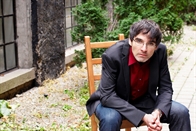 One of the most inventive songwriters to come out of the contemporary scene in Canada, Frank Horvat is an award-winning composer whose music explores a wide array of themes — from love to social justice issues.
One of the most inventive songwriters to come out of the contemporary scene in Canada, Frank Horvat is an award-winning composer whose music explores a wide array of themes — from love to social justice issues.
Horvat’s debut ATMA recording, For Those Who Died Trying, features the world premiere recording of his composition The Thailand HRDs, an epic 35-movement string quartet commissioned by the NGO Protection International and performed by the Mivos Quartet, to be released on November 16, 2018.
1. Comment la musique est-elle entrée dans votre vie?
1. How did music first enter your life?
When I was five, my parents and I visited family friends. Their daughter played the electric organ and I was completely enthralled. I begged my parents for lessons. They took me to a music school that suggested I start learning the accordion (because I was too small to reach the pedals on the organ). I got pretty proficient with the accordion and eventually started the piano…I haven’t looked back since.
2. When did you first begin exploring composition?
Around the age of 9 my piano and theory teacher encouraged me to compose as a means of honing my theoretical knowledge. I enjoyed it immensely. My first piece was called Sabrina (character from an Archie comic). It was scored for accordion, bassoon, synthesizer and bass guitar. It was entered in the local Kiwanis Music Festival. I won first place (I was the only entrant in that class.)
3. As a composer, where do you draw your inspiration?
It might sound cliché to say, but EVERYWHERE! I write a lot of music so I tend to be constantly looking for new ideas and inspirations. Many times, non-musical places are where I go creatively, especially if it tells a story of love, triumph or injustice. But sometimes I tend to just focus on patterns and textures…I guess I’m sort of a minimalist at heart. Other art forms are huge for me, especially visual art and literature.
4. How have your musical tastes changed over the course of your career?
That’s a challenging question because I try not to be conscious of this, as I fear it might lead me to compose what I think others want to hear. My compositional process is to sit down and simply write whatever feels right at that moment. It can be very tonal or very dissonant. It could be a short miniature or a 60-minute composition. I think that’s why my portfolio is filled with such variety. It probably makes it harder to get my music “out there”, but I honestly don’t care because most importantly I want my music to reflect the multi-faceted me.
I will admit that one general trend over the past bunch of years has been my acceptance of writing music that is more calm, slow and spacious. The younger me probably would have not approved as the younger me enjoyed battering the listener over the head with intensity and a lot of notes. But the young and old me would both agree that we love a beat!
5. What are the most common misconceptions people have about the way composers work?
Not quite sure as I think a lot of composers have their own unique process. As for me, people might be surprised by how much I edit. I really love to improvise in my composing process. That basically means I gush out a lot of ideas very quickly but then I need to carefully curate and organize all of them. It can take forever! Even though it might sound tedious, I love that process just as much as the initial raw-idea phase.
6. Whose idea was it to use Luke Duggleby’s photo essay For Those Who Died Trying as the springboard for The Thailand HRDs?
It all happened very randomly. I was leafing through the New York Times website and came across an article about Luke’s photo essay. I was so moved by what I saw and read, I decided at that very moment that I was going to compose a suite a pieces based on every photo. For some reason, a string quartet felt like the right type of instrumentation. I initially composed 4 movements before apprehensively presented them to Luke and Protection International, not knowing if they’d like this addition to their important project. Thankfully they liked what they heard and I finished the remaining 31 movements for them.
7. How much interaction (if any) did you have with Luke while composing the piece?
None whatsoever. His portraits and their captions did all the talking and it was remarkably easy to compose. When all 35 were finished, I presented my MIDI demos to Luke, and he loved them. I’m so very lucky to have found such a fellow creative soul.
8. How do you prepare for a commission like this one, which bears a considerable weight of responsibility towards the legacy of those who were killed?
I thought about that before I started composing the remaining 31 movements. But when I dove in and started writing, I didn’t really think of it, as I know that I was sharing my interpretation. Any arts project is that artist’s POV. In that sense, any of my “social justice” compositions are very personal to who I am and I how I feel about the subjects. I tend to only appreciate the impact that the composition can make on bringing awareness and paying homage to its subjects after the fact. I think that separation in the creative process is an important thing.
9. Has the piece been performed live, and if so, what was the audience reaction?
The world premiere performance took place at Mount Pleasant Cemetery in Toronto earlier this year. Mivos performed it live the day before the recording sessions began. Prior to that day, I had never met the members of the quartet or heard them play the piece. It was amazing! As a composer, sometime a first performance can be hit-and-miss since it takes time to iron out the kinks in the composition. But they performed it as if they had been playing it forever – a collaborative match made in heaven. To have the performance in Mount Pleasant’s architecturally-stunning memorial hall was inspiring. When The Thailand HRDs is performed live, it’s not just a concert. It’s also a memorial service to the victims depicted in the photos and music. To have it performed in such a contemplative place, was a poignant experience. I felt honoured to get so many wonderful comments after the performance and online about how the music made everyone feel. It reminded me that music has such an important place in grieving. None of us in the hall that day had ever known any of the victims depicted in the photos personally, but somehow the whole presentation made the audience feel like they had. That for me is the ultimate measuring stick of creative success.
10. What upcoming projects are on the horizon for you?
As I mentioned, I am constantly composing so that means there’s always something to share with the world. I try to put out a new album of my compositions every year. This fall, I start producing an album of chamber music called, What Goes Around…, all based around looping musical ideas. Each piece will be performed by just one musician but with the miracle of technology, they will overdub themselves to create a textured effect. I’m so fortunate to have fantastic musicians working on this project including Beverley Johnston (percussion), Sharlene Wallace (harp) and Peter Stoll (clarinets). Jean Martin (Tanya Tagaq) and I will collaborate once again to put all this together. Hope to have this album come out in 2019.
I’m also presently composing a musical about seniors, I regularly compose film/tv music and I’m also performing my solo piano compositions quite regularly. I love to sit at my desk coming up with musical ideas but I also still have the emotional need to share my music live and connect first-hand with audiences.
11. Anything else you’d like readers to know?
I’m so grateful that so many wonderful partners randomly gathered from every corner of the planet to make the album, For Those Who Died Trying, a reality. I hope the music touches the hearts of listeners but also motivates them to delve deeper into making the world a better place for everyone.
